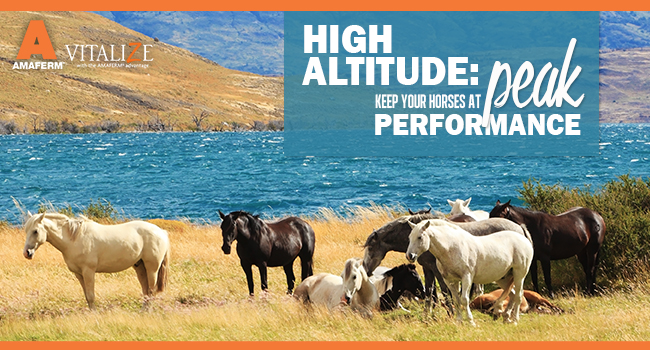Regardless of their fitness level, many horses may not perform the same at high altitudes as they would at sea level. Although it seems to effect horses somewhat less than humans, altitude begins to take its toll on horses above 5,000 feet and is prominent above 7,000 feet. At high altitude the air pressure is lower and there are fewer molecules of oxygen present in the air. For every 1,000 feet above sea level that you travel, the amount of oxygen in the air decreases by approximately 3%. That means that at 7,000 feet there is 20% less oxygen molecules available per breath! Therefore, the horse’s body must make adjustments to compensate for the difference.
The most obvious way for the horse to compensate is by increasing its respiration rate, or taking more breaths per minute. As the respiration rate increases so does the heart rate in order to pump oxygenated blood throughout the body. The body also responds by beginning to generate more red blood cells and capillaries to assist in oxygen transportation. This takes somewhere between 4 to 7 days. After that “acclimation” period, a horse at high altitude may have up to 50% more red blood cells than a horse at sea level!
In order to protect vital organs such as the brain and heart, the body also shifts blood flow. As a result, more blood flows to the brain, heart, and lungs and less flows to the other organs in the body such as the digestive organs. The negatives of this protection mechanism are headaches (caused by a sharp increase in the amount of blood flowing through the cranial arteries) and digestive upset (caused by the decrease in blood supply to the digestive organs). But perhaps the largest concern for horses at altitude is dehydration due to the dry air and increased respiration rates. In fact, above 6,000 feet the body exhales and sweats nearly twice as much moisture as it would at sea level.
While a horse that lives continuously at high altitude will adjust to these conditions, they can be stressful to horses traveling to high altitude. If possible, it is best to allow a couple of days of acclimation time before asking a horse to perform his best. However, this is not always possible. To help your horse adjust more smoothly, we recommend Amaferm Equine Recovery Gel twice daily during shipping and for the first 3 to 5 days at high altitude and Vitalize® Equine Digest More Plus daily for maintenance. Amaferm Equine Recovery Paste is formulated with Amaferm to enhance gut health, MOS to eliminate digestive upset, and vitamins and minerals to replenish and renew your horse for maximum performance. Amaferm is also research proven to increase water intake by 9.5%, fighting dehydration and giving your horse a huge advantage no matter where you are!


